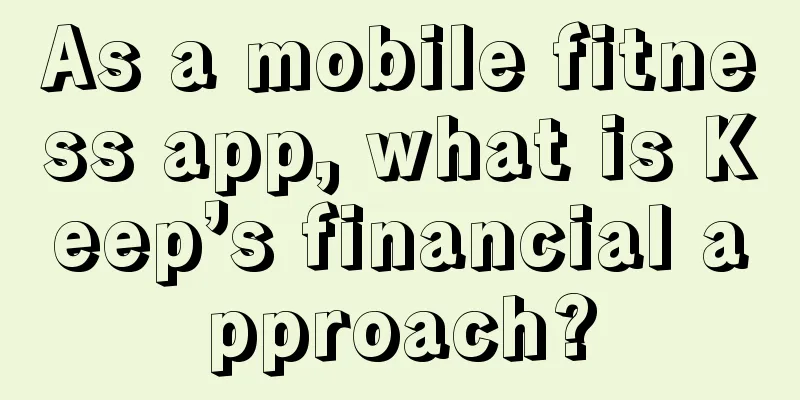As a mobile fitness app, what is Keep’s financial approach?

What is Keep?Keep is a mobile fitness app that was launched in February 2015. It was named the App of the Year by the App Store that year. As of today (August 14, 2016), it still ranks first in the free ranking of health and fitness in the App Store. Keep has always focused on the fitness field. Its core function is to meet the needs of different groups of people, especially training courses for sports novices, and has gradually added community functions and social attributes. After the release of version 3.0, the two major functions of running and e-commerce were officially launched. It gradually transformed from the initial mobile fitness tool to a sports platform and began to explore commercialization starting with e-commerce. According to data from online searches in May 2016: Keep has 60 million registered users and 11 million monthly active users. The amount of funds that Keep can concentrateCurrently, Keep has 60 million registered users and 11 million monthly active users. We assume that of these 11 million users, 10% (or 1.1 million) will complete a 30-day fitness course every month. Among them, 10% (or 110,000) of users are willing to use investment courses. [Note: Investing in courses means that for each fitness course customized by the user, it is necessary to invest 1,000 yuan. After the course, you can get income based on the completion status. The higher the completion status, the higher the income. 】See Figure 1 for specific funnel conversion: Figure 1: Keep investment course funnel conversionAccording to this data, the amount of funds that Keep can concentrate each month is: monthly fund size = 110,000*1000 = 110 million yuan . Figure 2: Ranking of transaction volume of online lending platforms in July 2016 (Photo courtesy of Wangdaizhijia)As shown in Figure 2, based on the transaction volume of the online lending platform in July 2016 viewed on Wangdaizhijia.com, the scale of funds is 110 million per month. If converted into transaction volume, it is probably around 150th of the online lending platforms. Currently, there are more than 2,200 online lending platforms in normal operation . Therefore, this scale of funds is also at the forefront of the industry. With the increase in the number of registered users of Keep and the coordinated operation and promotion , the scale of funds should be able to double several times. With the rise of Internet finance, the investment and financial management of the vast majority of users are still concentrated on money funds similar to Yu'e Bao, or financial products that are essentially P2P. From the perspective of the returns of these financial products, there are two types:
Therefore, as long as it can make a profit, it is generally feasible. In terms of capital scale and returns, it is feasible for Keep to enter the financial sector, but how should it position itself and differentiate itself from other financial products by leveraging its own advantages? Keep’s financial positioningAt present, financial management product platforms are emerging in an endless stream. If users choose financial management, they basically consider aspects such as security and rate of return. If Keep's financial management is similar to other platforms in terms of target population and operating model, then it will basically have no competitiveness and will be in a zero-sum competition market. Inspired by Peter Thiel's method of building a monopoly enterprise in "Zero to One": occupying small markets, expanding scale, and disruptive innovation, Keep can enter the financial management market for fitness people, thereby differentiating itself from existing financial management products and customizing fitness financial management products exclusively for fitness people. Fitness is an investment return on physical health (weight loss, body shaping, etc.) obtained through exercise, while investment is an investment return on asset appreciation obtained through financial management, so I call this product a fitness financial management plan. Fitness Financial Plan DetailsInsurance financial management is to rationally arrange and plan funds through the purchase of insurance to prevent and avoid financial difficulties caused by illness or disasters, while at the same time enabling assets to achieve ideal value preservation and appreciation. Its characteristic is that it combines insurance protection and investment functions in one. With reference to insurance financial management, I give a definition of fitness financial management, which is to invest a certain amount of money in the development of fitness plan courses to ensure that individuals achieve their fitness goals, prevent interruptions and abandonment of fitness courses, ensure completion of courses and obtain capital appreciation.
Participants of the Fitness Finance ProgramFrom the perspective of the minimum number of participants, this financial management plan will involve three main bodies: users, platforms, and financial assets. Figure 3: Keep main participantsUsers customize fitness investment plans on Keep, and Keep collects idle funds from users and manages them by cooperating third-party financial management companies. After deducting various fees, the third-party financial management companies pay the profits to the platform; the platform redistributes the profits to users. Demand feasibility analysisThe realization of any demand or function can solve a certain problem or generate creative needs under a certain user scenario. From the perspective of financial approach, a very important point is: why do users want to customize this plan? How to ensure that users will actually purchase this financial plan? How likely is it that users will engage in financial management with fitness products? In terms of the attributes of the product itself, it is difficult for users to invest too much money in a fitness app for financial management, and the 1,000 yuan I imagined is a relatively high number. It is very likely that the expectation of the vast majority of users is only 100 yuan. But the amount is too small and it is difficult to generate much profit, making it difficult to attract users. Therefore, if considered from the perspective of financial returns, this idea is basically a false proposition. Therefore, from the perspective of motivating fitness users, this fitness financial management plan aims to solve the problem of users' persistence in fitness, and the way to achieve it is financial management returns. The real need is to use income as an incentive to urge users to persist in fitness and better complete their fitness plans. First, completion incentives are an additional option for customized plans, and users can decide for themselves whether to choose them. Psychologically, users will not feel forced to behave, which will reduce their resistance. Secondly, if users invest money, they will pay more attention to the adherence to the plan, which can motivate users. And the benefits of incentives are positively correlated with completion status. In reality, many people will sign up for an annual gym membership, but in reality they only go there a few times. However, many users will still apply for expensive annual memberships, because most users think in their minds, "I have such an expensive annual fitness membership, I must stick with it, otherwise I will lose a lot." Therefore, from a certain perspective, users will use investment courses for the same reason. User operation processHere we only use a few rough pages to introduce several main processes involved in front-end users to describe the ideas: 1. On the home page, the user selects Customize Course Schedule and enters the course description details page, as shown in Figure 4: Figure 4- Home page2. If the user chooses to complete the customization, the normal Keep process will still be followed. If the user chooses to sign an incentive financial plan, he/she will enter the financial details page, as shown in Figure 5: Figure 5-Course details page3. On the financial management details page, some details of the financial management plan are mainly introduced, including product features, profit rules, repayment methods, etc., as shown in Figure 6. Once the user clicks to confirm the contract, the payment process will begin. In the payment purchase process, processes such as card binding and account opening are skipped here. Figure 6-Financial management details.png4. The contract is signed successfully, as shown in Figure 7: Figure 7-Signing Successfully5. When the user completes the course, the actual benefits obtained by the user will be calculated based on the completion status. Figure 8: Figure 8-Complete the courseIn addition to these basic processes, a complete financial account system must be established. The account system is the core function and foundation of a financial product. The most basic function is the recharge and withdrawal function. At present, this area has not been carefully studied and will not be discussed. Mobile application product promotion services: ASO optimization services Qinggua Media information flow The author of this article @可飞 is compiled and published by (APP top promotion). Please indicate the author information and source when reprinting! |
<<: Data analysis of Internet finance platforms: These three models are enough
Recommend
It’s the last month, try harder!
After today There is only one month left in 2021 ...
Tremble, humans! After AlphaGo, there is the Cold Poker Master
I'm afraid everyone started paying attention ...
7 Things Your Boss Doesn't Know About Software Development
Does your boss not understand your job? This arti...
Mobei Class SEO Course 9th VIP Course 10th Optimization SEO Course 2020 Synchronous 10th
The 9th session of SEO training has started, and ...
What do scientists think of the Tonga volcano eruption?
The massive eruption of an underwater volcano in ...
Swimming mice, bulbous-nosed fish: Scientists discover 27 new species of creatures in unexpected places
Located in northern Peru, between the Amazon rain...
Are diseases easily spread in public toilets? Can we still squat on the toilets in public toilets?
"Public toilets" have always been a con...
Crow Redemption Combo Love Chat Method 1.0, Love Quotient Chat Course 1.0, 2 sets of new combo tutorials
Crow Redemption Combo Love Chat Method 1.0, Love ...
5 marketing strategy ideas to build a brand with lasting competitiveness
Whether it is as small as a promotional activity ...
Investment and Financing Analyst Training Class (Level-I) CIFA System Course
Investment and Financing Analyst Training Class (...
Tips for making popular “short video” ads!
There are three main elements in Internet adverti...
How to use Xiaohongshu for marketing, the ranking mechanism has been leaked!
Xiaohongshu is very popular now, and major beauty...
Captain Da Shanzhaowan's Notes | Deep Sea Part 1
Big Sea The earth is the mother of mankind. She n...
Earthlings have been working hard to find extraterrestrial civilizations
Recently, many media outlets have reported that t...
Do computers have vision? Let computers "see" the world
1. The Birth of Vision In the billions of years s...









